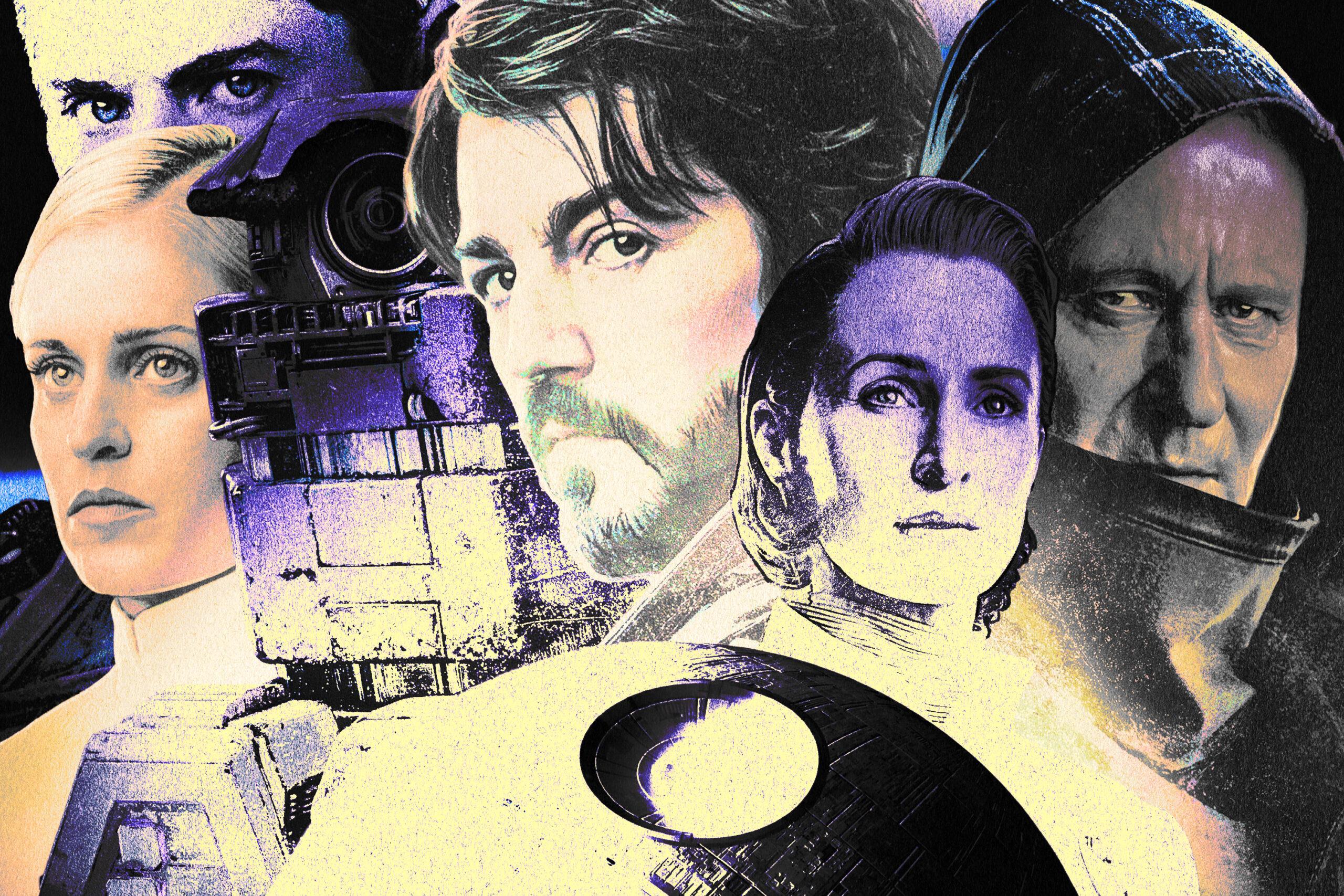
The triumphant first season of Andor is over, but the assessments of its influence on future IP projects have only just begun. Will the critical acclaim that greeted Andor usher in a new approach to prequels and spinoffs in established fictional universes, at Disney and beyond? Has Tony Gilroy’s grounded, serious storytelling paved a path for a multitude of more mature concepts stewing in other writers’ brains? (My Star Wars series pitch: A Borgen-style drama revolving around morally bankrupt political chameleon Mas Amedda. Kathleen Kennedy, call me.) Or will Andor, thus far dogged by modest viewership, remain an outlier—an experiment rarely replicated despite rave reviews and potential award wins?
These are fascinating big-picture questions for fans, executives, and creators to consider. While the industry wrestles with those long-term ramifications, though, there’s a more pressing matter to address: Gilroy and Co. have to make more Andor. In fact, they’re making more right now! Andor’s second (and, sadly, final) season, which entered production last month, won’t be out until 2024. But before we set our anticipation and speculation to “simmer” and fully turn our attention to The Bad Batch, The Mandalorian, Ahsoka, and more Star Wars releases in the Lucasfilm pipeline, here are my five biggest questions concerning Season 2.
What’s left for Andor to do?
The character, that is, not the series. For most of the cast, and for the fledgling Rebellion at large, there’s plenty of story still left to unspool before Andor catches up to Rogue One’s place on the Star Wars timeline. But if “Rix Road” had been Andor’s series finale instead of the climax of Season 1, Cassian’s arc would have felt fairly complete.
Gilroy told Variety that he’d long known what the final scene of Season 1 would be, explaining that “this first half of the show was in my mind called The Education of Cassian Andor. How do you take somebody from being a disillusioned, cynical, self-interested loser, to becoming committed to something and understanding what they’re committed to?”
That’s quite a large leap, but Gilroy and Diego Luna landed it: Cassian’s Season 1 arc is convincing, transformative, and moving. From a character-development perspective, then, uneducated Cassian almost certainly covered more ground in Season 1 than educated Cassian can in Season 2. At the start of Season 1, he’s willing to kill to save himself. At the end of Season 1, he’s willing to kill, and die, to save others—and to destroy the Empire, which is essentially where we find him in Rogue One.
Which isn’t to say that Cassian’s work here is done. Now that he’s chosen a side, he’ll have to familiarize himself (and by extension, the audience) with Luthen’s operation, and learn the finer points of spycraft. He’ll have to confront the tension between the idealism of his recent reading material—Nemik’s manifesto—and the unsavory realities of trying to win a war. (Though he’s hardly a stranger to unsavory realities.) At some point, he’ll have to link up again with Bix and the other refugees from Ferrix, and he’ll have to meet K-2SO—though if Gilroy abides by established canon, that won’t happen until less than two years prior to Rogue One, in the second half of the season. And he’ll have to elude pursuit by Syril, Dedra, and the long arm of the ISB.
He may also resume his search for his sister, though when questioned last week about that dormant plot line—which was introduced in the first scene of the series—neither Gilroy nor Luna firmly committed to picking up the thread. As I’ve already written and said, I’d be surprised if that setup went nowhere; at the very least, it would be weird if we never knew what happened, and how the kidnapped Kassa reacted, after waking up on Maarva’s ship, separated from his sister. My best guess is that the details surrounding Kenari and Cassian’s sister were purposely obscured because the planet’s devastation was in some way connected to the early construction of the Death Star, which would mean that Palpatine’s superweapon had dictated the course of Cassian’s life from cradle to grave. My second-best guess is that we’ll never know; Season 2 will have a ton of ground to cover and only so much screen time to spare, and staying one step ahead of the bad guys could keep Cassian too busy to look for long-lost relatives.
I’d enjoy just seeing Cassian do some spy stuff now that he’s not a mercenary but a committed member of the team. But as Luna himself has conceded, Andor has been an ensemble series from the start, so it’s possible that the second season will see the ostensible lead take a backseat to other characters whose futures are unknown. However, there is one longstanding source of suspense that Cassian alone can settle. Gilroy has hinted that the second season could rectify the first season’s shortage of nonhuman characters. Could Luna at last discover the texture of Jabba before he steps away from what could be his last live-action appearance in Star Wars?
What will we learn about Luthen?
There’s only so much uncertainty surrounding Cassian, considering we’ve seen when and how his story ends. There are higher stakes attached to the safety of Mon Mothma’s family, though A) most Andor watchers wouldn’t mourn her husband or daughter that much, and B) they aren’t necessarily doomed; for all we know, Perrin spends the Galactic Civil War blissfully playing the slots on Canto Bight, while Leida and Davo Jr. live happily ever after. But the greatest amount of mystery, and the heaviest emotional-wallop potential, are reserved for Luthen, an original and highly compelling character whose absence from subsequent Star Wars events suddenly seems conspicuous.
Given his monologue about burning his life to “make a sunrise that I know I’ll never see,” Luthen’s prospects for survival seem slim. But even if Luthen goes down in flames before the final credits roll, Season 2 could clarify the part he (and, perhaps, Kleya, Vel, and Cinta) played in the origin of the Alliance, thereby recontextualizing Rogue One and the Original Trilogy. The journey to whatever fate awaits him promises to be fraught: Luthen has long lived in the shadows, but Gilroy has indicated that the second season will reckon with what it means for him to operate in the open as the Rebellion ramps up. As Luthen’s attack on a cruiser in Episode 11 and his trip to Ferrix in the finale indicated, he’s clearly spoiling for a fight, and he’s willing to risk blowing his cover. For now, he seems essential as a bridge between the rigidly reserved Mon and the half-unhinged Saw—though Luthen’s tactics are arguably just as extreme as Saw’s, if not more so.
One theory we can probably lay to rest: Unless Tony Gilroy is a master of the misdirect, Luthen likely isn’t a secret Jedi. Yes, he has an affinity for robes; yes, he carries a knife/walking stick with a hilt that kind of looks like a lightsaber’s; yes, he has a Kyber-crystal necklace and an inventory of Jedi/Sith artifacts; and yes, his Haulcraft shoots solid laser beams that look lightsaber-esque. But no, he’s almost certainly not an Order 66 survivor. For one thing, he’s living, working, and hobnobbing with bigwigs on Coruscant, the seat of the Empire’s power. That’s the worst place in the galaxy for a fugitive Jedi to be, and barring some sort of facial transformation program, it’s hard to see how a Jedi who would’ve been long past the Padawan stage when the Jedi Temple was sacked could have stayed so close to the scene of the crime for so long.
Beyond that, though, there’s what we know about Gilroy and his preference for largely Force-free Star Wars stories. Asked on a recent screenwriting podcast whether the lasers on Luthen’s ship use Kyber crystals, Gilroy tolerantly replied, “I don’t know the answer to this question.” Asked about Luthen’s lightsaber-looking accessory, Gilroy responded, “He needs to have a fuckin’ staff, he needs to have a weapon. So I go to the props department, and we pick one. I don’t want to shut down any avenues, but you have to ask yourself, what do you think I’m interested in?” (You can almost hear him thinking, “Get a life, will you, people?!”) The showrunner also noted that aside from those supposed clues—which Gilroy, a self-professed non-expert in Star Wars lore, might not even have recognized as such—“we have not laid any bread crumbs towards ‘Jedi.’”
Assuming Season 2 ever fully lifts the lid on Luthen’s origins, his backstory will probably turn out to be much more interesting than the most obvious solution. Andor isn’t in the business of feeding us something we’ve seen before. But before it bows out, I’d love for it to feed us more intel on Luthen, his connection to Kleya, his ties to Mon and Vel, and the vow that these insurgents swore when they made common cause.
Are Syril and Dedra Andor’s OTP?
OK, probably not. But if, as Maarva said, Cassian is “the first spark of the fire,” then whatever’s been brewing between Karn and Meero must be spark no. 2. If gazing into someone’s eyes for four minutes can make you fall in love, then these two true believers, who barely blink, can’t help but be meant for each other.
In all seriousness: Syril and Dedra are a difficult-to-read duo, which is what makes their relationship such a strong hook for Season 2. Syril remains a cipher, someone who could break bad or good to any degree and play almost any number of roles in the remainder of this story. Tracking down Andor (only to lose him) wasn’t enough to get him into Dedra’s good graces (if she has good graces), but surely saving her life must have earned him an ISB internship—though Dedra herself may be kicked to the curb by the Empire after presiding over the Ferrix fiasco.
If some sort of teamup ensues, Syril may not have the stomach for what working with Dedra entails. After subjecting Bix to the death cries of the Dizonites, Dedra seems irredeemable, though she wouldn’t be the first TV torturer to try to atone for past atrocities. In interviews, Gilroy has hedged on the subject of Syril’s moral compass, seeming to signal that it’s not too late for him to pull back from the brink, but a standard redemption/defection arc seems too pat an outcome for Andor.
While we’re discussing Syril, here’s a bonus question to ponder: Who the heck is Uncle Harlo?
How will the accelerated timeline work?
Like most of the first season, Season 2 will be broken up into three-episode blocks. But whereas Season 1’s 12 episodes covered roughly one year combined, Season 2’s will cover four years, with one year elapsing between blocks. (Thus, the Season 2 premiere picks up a year after “Rix Road.”) Season 1 bore the burden of making us care about characters we either didn’t know or didn’t know we needed to know more about. Season 2, which will be written by the returning trio of Tony and Dan Gilroy and Beau Willimon (plus fourth musketeer Tom Bissell) and directed by Andor newcomers Ariel Kleiman, Janus Metz, and Alonso Ruizpalacios, has a different but no less daunting task: to fast-forward right up to the murder that introduced us to Cassian for the first time.
“When we come back, it’s a year later, and it’s a Friday, Saturday, and a Sunday,” Gilroy teased in August. “And then we go away for a year. And then we come back for, I think, eight days. And then we go away for a year. And we come back, and it’s four days.” The last block, he said elsewhere, will cover “the last five days before Rogue One.” Perhaps unsurprisingly, given Gilroy’s big-screen background, this sounds less like a season of TV than like a series of movies. (You know, those things in theaters that Lucasfilm used to make.)
Gilroy is aware of the problems posed by time jumps. It’s one thing to take sizable leaps between seasons. It’s another to skip ahead substantially multiple times within the same season, a structure that sometimes disrupted Season 1 of House of the Dragon. The jumps won’t be nearly as drastic in Andor, and shouldn’t require recasting. But even though Gilroy intends to make the “negative space” between blocks “really, really huge and fantastic and important,” there’s still a risk of leaving viewers confused or making them lament missing all the action they’ll have to hear about or infer instead of seeing.
Andor was originally envisioned as a five-season series, before Gilroy and Luna decided to condense it to two so as not to chain themselves to the series for a decade or more. The worst-case scenario is that upping the pace makes Season 2 feel rushed, much like the latter seasons of Game of Thrones, which dispensed with earlier seasons’ subtlety and artistry in service of dispensing as much plot as possible. The best-case scenario is that it’s just as satisfying as Season 1—in which case we’ll still be sorry that we won’t get to spend at least, say, three seasons with this series. One of Andor’s strengths in Season 1 was that it had time to spend on seemingly nonessential scenes (such as Syril’s sulky cereal breaks) that added to the complexity of its characters and richness of its settings. Here’s hoping Season 2 retains the luxury of slowing down, even as it speeds up.
How Star Wars-y will the second season be?
In Season 1, Gilroy exercised extreme restraint in deploying the traditional signifiers of Star Wars, opting to create his own locations and iconography rather than rely on famous sights from the franchise’s past. Until, that is, the stinger buried within the credits for the finale, which gave us a lingering glimpse of the Death Star and its man-made components from the prison on Narkina 5. That scene may have set the tone for Season 2, given that the well-loved and well-trod territory of Rogue One and the Original Trilogy will draw nearer by the episode.
Even before Season 1 started, Gilroy guaranteed that the series’ legacy-character cameos would “never [be] fan service.” Any connections to existing Star Wars stories, he said, would “never [be] cynical. It’s always meant to be there. It’s always protein; it’s never icing.”
As the Alliance expands and Cassian approaches his date with destiny, though, it will take less and less lifting (or icing) to have him or other characters cross paths with familiar faces. As the Death Star approaches completion, could Orson Krennic, Galen Erso, or CGI Wilhuff Tarkin return? Might Darth Vader or Emperor Palpatine make appearances? Season 2 will feature the Rebel base on Yavin, so what about Alliance organizers Bail and Leia Organa; military leaders such as Gial Ackbar, Jan Dodonna, Carlist Rieekan, and Crix Madine; or pilots like Wedge and Hobbie? And could Cassian encounter the core characters from Rebels and the upcoming Ahsoka, such as Ezra Bridger, Sabine Wren, Hera Syndulla, and Ahsoka herself?
I’m going to guess that Gilroy hasn’t watched Rebels, and I doubt he’d incorporate Ahsoka crossovers just for synergy’s sake. But the closer Andor’s narrative comes to its inevitable destination, the more existing touchstones the series will need to navigate around. The efforts of Fulcrum informants, the Ghorman Massacre, Mon Mothma’s resignation from the Senate, the official founding of the Alliance—these and other developments are largely set in stone. Andor doesn’t have to show them, but it will be forced to respect them, set them up, or respond to them—all while continuing to carve its own, unique course through the canon. That won’t be a simple assignment, but it may not prove prohibitive for the people who made a prequel to a prequel the most impressive Star Wars series yet.

